Dirk Derks
Países Bajos
Volver al Indice de Amigos / Back to Index of Friends
Grumman Tracker
Hasegawa - 1:72
El S2F (= STOOF) tuvo mucho éxito en el servicio de la Armada Real de Holanda. Sirvió en el portaaviones Hr.Ms. Karel Doorman, varias bases aeronavales en los Países Bajos y las antiguas Antillas holandesas en el Caribe. Hubo dos tipos de unidades, la estadounidense y la versión canadiense. La versión estadounidense casi siempre se embarcó en el Grupo de Transporte Aéreo.
El diorama
El Tracker anclado a la cubierta de portaaviones y su tripulación posa frente a él para una sesión fotográfica.El modelo es de Hasegawa, incluyendo cockpit y alojamiento de bombas de Eduard. Las figuras son del diseñador holandés Hugo Petier. La vitrina es de MRC.
The S2F (=STOOF) was very successful in service by the Royal Netherlands Navy. It served on the aircraft carrier Hr.Ms. karel Doorman, several naval Air Stations in the Netherlands and the former Dutch Antilles in the Caribbean. We had two types, The US and the Canadian version. The Us version was almost always embarked in the Carrier Air Group.
The Diorama
Tracker lashed to the deck off the carrier. Crew is posed in front of it for a photo shoot. The model (1/72 scale) is from Hasegawa.Including: Eduard Cockpit/Eduard Bomb bay. The figures are from Dutch designer Hugo Petier. The display case is from MRC.
Westland Wessex HU5
Italeri - 1:72
FAA 771 Squadron, Base aeronaval Culdrose, 1984
FAA 771 Squadron, Naval Air Base Culdrose, 1984
HR.MS. Karel Doorman R-81
Heller - 1:400
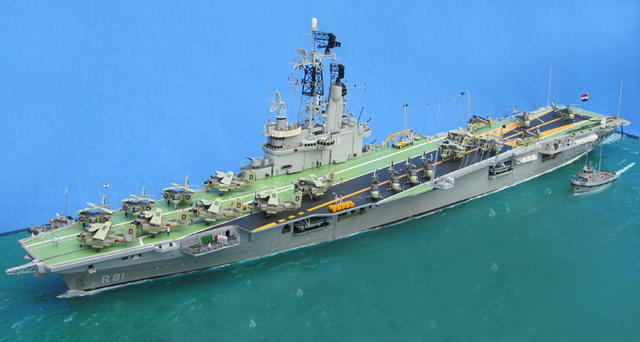
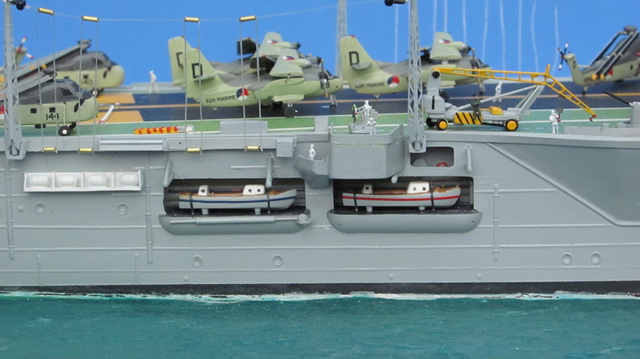
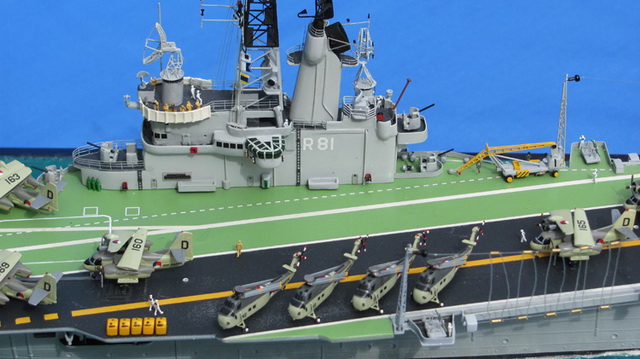
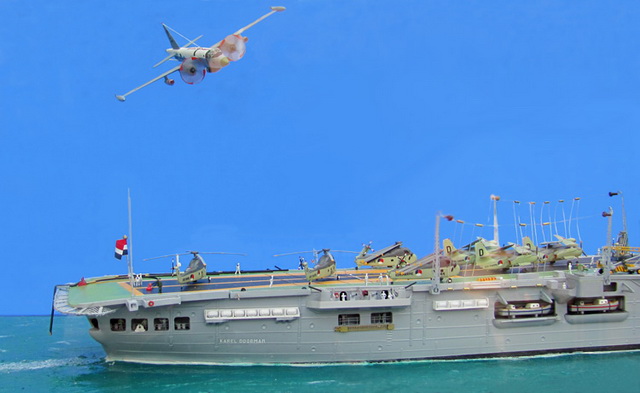
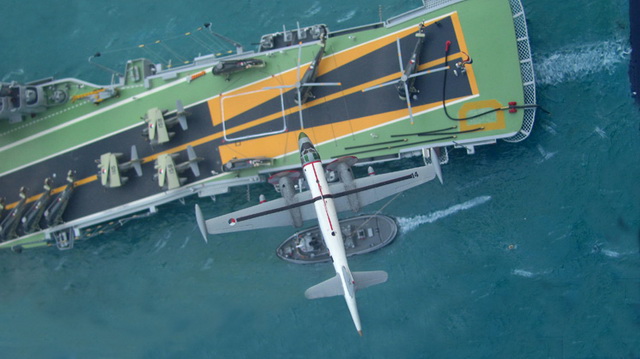
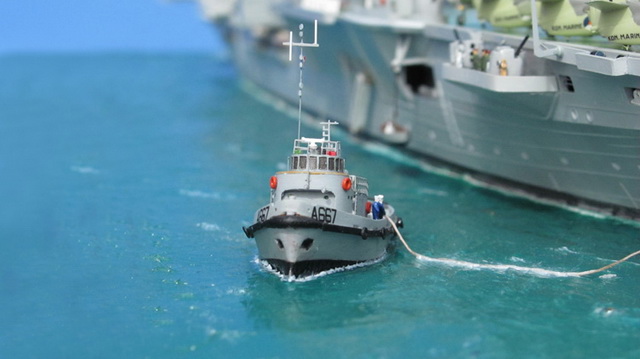

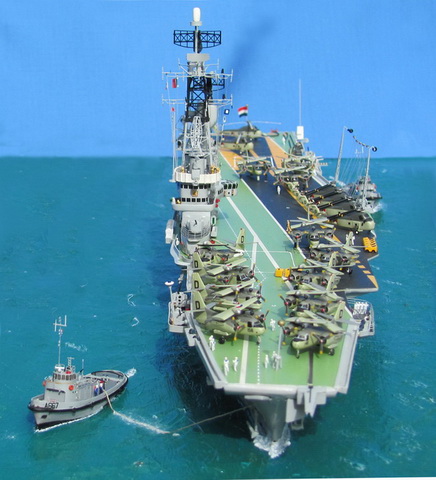
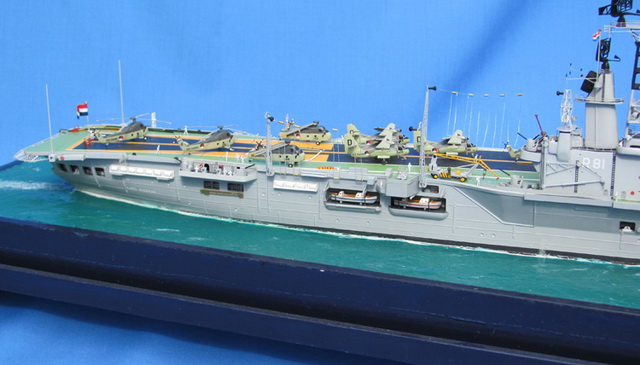
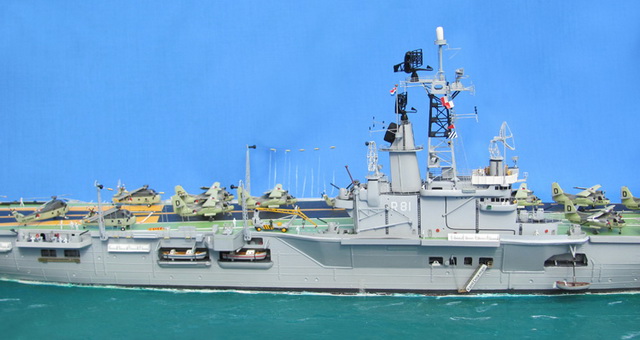

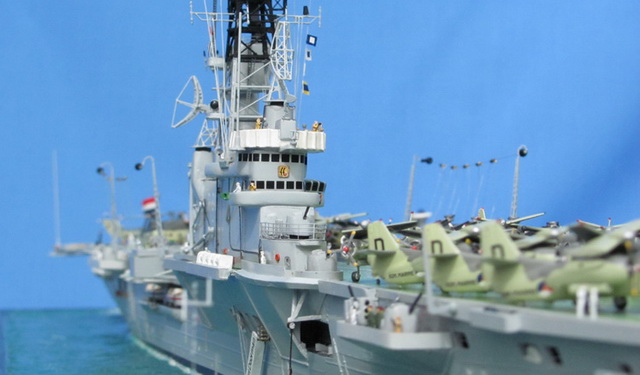
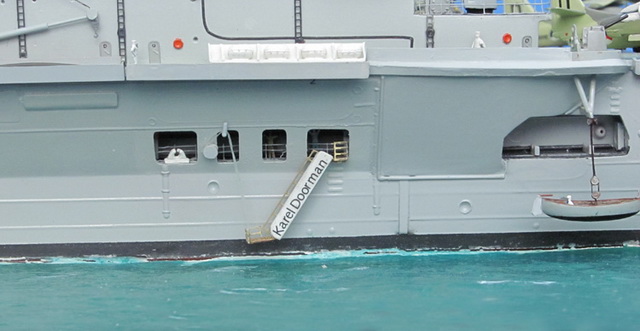
Breve Historia:
Tipo: Portaaviones ligero.
Orden del Almirantazgo Nº J3697 / Astillero Nº 1126
Botado el 3 de diciembre de 1942, astilleros Cammel Laird & Co Ltd. Birkenhead.
Completado: 17 de enero 1945
Historial de Servicio:
Royal Navy 17 mayo 1945 a 28 mayo 1948
Nombrado "HMS Venerable".
Marzo 1945-marzo 1947: Flota del Pacífico (BPF) Liberación de Hong Kong, repatriación de miles de ex presos, soldados y equipos, entre Fremantle, Bombay, Batavia y Singapur. Vendido al Gobierno holandés en 1948.
Royal Netherlands Navy 28 mayo 1948 hasta 8 octubre 1968
Nombrado "Hr.Ms. Karel Doorman"
1955-1958 amplia modernización, en Astillero Wilton-Feijenoord de Holanda. Durante este tiempo fue equipado con una nueva catapulta de vapor, cubierta inclinada, y el espejo de aterrizaje, nueva isla, mástil y chimenea, también se instaló un equipo de radar ultra moderno de búsqueda aerea, búsqueda de altura, obtención de blancos, navegación y el sistema radar de aproximación controlada. Estos fueron entregados por la famosa empresa electrónica Holland Signaal (ahora Thales)
Información general después de reacondicionamiento:
Longitud: 214 metros - Anchura : 34,80 metros - Calado: 7,30 metros - Desplazamiento : 13.800 toneladas.
Dos salas de máquinas, 40.000 HP- 2 ejes - 1 timón, - Velocidad máx 24,5 nudos
Armamento: 10 x 40 mm Bofors AA - Tripulación : 1500 incluyendo grupo aéreo.
Grupo de Aire 1958-1962 Grumman Avengers, Hawker Siddely Sea Hawk-Sikorsky HO4-S3 (S55)
Grupo Air 1962-1968 Grumman S-2A Tracker-Sikorsky HSS-1N Seabat
Con sólo Trackers anti-submarinos y helicópteros, el portaviones se convirtió en un buque antisubmairno (CVS).
El buque ha participado en muchos ejercicios de la OTAN y estuvo principalmente operativo en el Atlántico, el Mediterráneo y las aguas del Caribe.
Una excepción fue el despliegue mundial en 1960, con una duración de 7 meses.
En 1968, fue severamente dañado por un incendio en la sala de máquinas y posteriormente vendido a Argentina.
"ARA 25 de Mayo"
En servicio: 1 de septiembre de 1969. En el año 2000, fue remolcado a Alang (India) vendido como chatarra.
Un reacondicionamiento se llevó a cabo en el astillero Wilton Feijenoord. En su viaje inaugural a Argentina, el barco tuvo su primer encuentro con el prototipo del Sea Harrier británico, aterrizando en su cubierta por un posible interés por parte de los funcionarios de la Armada Argentina.
Durante la Guerra de Malvinas (1982) fue el buque insignia de la CTF 79/01, 3 mayo 1982, y le fue ordenado por el Alto Mando Naval para atacar al grupo de batalla de portaaviones británico, por Grumman Trackers, operando desde el POMA. Debido al hecho de que un ataque de noche no era posible para los A-4Q Skyhawk, y sabiendose detectado, el grupo de batalla británico se trasladó hacia el este y fuera del alcance de los argentinos. En el año 2000 el portaaviones fue remolcado a Alang (India) como chatarra.
El modelo, a escala 1/400
Combinación del kit de Heller (Arromanches), mejorado con resina, fotograbados y calcomanías de NavalModels.com, haciendo posible la representación del buque después de su importante reforma. (Cubierta en ángulo, nueva isla, y nuevo juego de radar).
Construcción:
Este kit multimedia necesita mucho trabajo, especialmente en el encastre de la resina con el plástico en grandes áreas. Un gran numero de fotograbados con radares, mástil principal, hélices, palas de los rotores, rotores de cola. Básicamente, los mismos elementos que se utilizaron durante la importante reforma verdadera.
Longitud en centímetros 56 / anchura en centímetros +8.
El modelo está construido en casco completo y colocado en una caja de madera. Esta caja se llena con yeso y se deja secar. Después de secado, la diferencia (3 mm) se llena con gel Liquitex esculpido con una cuchara. Este gel se endurece después de 24 horas. A continuación, se estudian imágenes del agua, para tomar la decisión final sobre los colores.
El Diorama representa el 3 de noviembre 1967:
En octubre de 1967, la Armada holandesa concentra un grupo de trabajo que incluyó once barcos, incluyendo el portaaviones, destructores, fragatas, submarinos, petrolero y efectivos de la Fleet Air Arm.
El 3 de noviembre, el Karel Doorman entró en la Base Naval de Toulon.
Por la llegada, dos remolcadores navales franceses le están ayudando para su anclaje. El grupo aéreo consta de los Escuadrones 4 y 8, totalmente armados en la cubierta.
Las anclas de estribor y babor se ven "presentadas" y listas para uso en caso de emergencia o durante el procedimiento de anclaje.
Un Lockheed Neptune (SP-2H / 214) del Escuadrón 320 está haciendo un vuelo bajo sobre la cubierta de popa.
Kit y accesorios:
El kit completo es de www.navalmodels.com
Los Grumman Trackers son de L'arsenal (www.larsenal.com)
Remolcadores de puerto navales franceses (Acharné Class) de L'arsenal
Cabrestantes, puertas estancas, carretes de extinción de incendios, de L'arsenal
Tripulación de North Star.
Lockheed Neptune de L'arsenal
Barandas de Tauro (www.tauro.com)
Otros detalles en scratch.
Libros:
British Aircraft Carriers de David Hobbs
The Colossus-Class Aircraft carriers 1944-1972 de Neil Mccart
Wings of the Malvinas de Santiago Rivas
Hr.Ms. Karel Doorman de Bert Brand
Verguisd en geprezen de LTZ1 Willem geneste.
Op de grens van zee en lucht (Lockheed Neptune F.C. Van Oosten)
Short History:
Type: Light Fleet Carrier.
Admiralty Job Number J3697 / Yard Number 1126
She was laid down on 3 December 1942, by the yard Cammel Laird & Co Ltd. Birkenhead.
Completed: 17 January 1945
Service Record:
Royal Navy 17 May 1945 - 28 May 1948
Named "HMS Venerable".
March 1945-March 1947: British Pacific Fleet (BPF). Liberation of Hong Kong, repatriating thousands of former prisoners, soldiers and equipment, between Fremantle, Bombay, Batavia and Singapore. Sold to the Dutch Government in 1948.
Royal Netherlands Navy 28 May 1948 - 8 October 1968
Named "Hr.Ms. Karel Doorman"
1955-1958 extensive modernization, at Wilton-Feijenoord Shipyard in Holland. During this time she was fitted with a new steam catapult, an angled deck, and mirror landing sight, new island, massive mast and funnel, also ultra modern radar equipment, air search, height search, target acquisition, navigation and carrier controlled approach radar system. These were all delivered by the famous electronic company Holland Signaal. (Now Thales)
General information after major refit:
Length: 214 meter. – Width: 34.80 meter. – Draft: 7.30 meter. – Displacement: 13800 ton.
Two engine rooms, producing 40.000 HP- 2 screws – 1 rudder, – Max.speed 24.5 knots
Armament: 10x 40 mm Bofors AA. – Crew: 1500 including air group.
Air Group 1958-1962 Grumman Avengers, Hawker Siddely Sea Hawk-Sikorsky HO4-S3 (S55)
Air group 1962-1968 Grumman S-2A Tracker- Sikorsky HSS-1N Seabat
With only anti-submarine Trackers and Helicopters, the carrier became a Carrier Vessel Submarines (CVS).
The carrier took part in many NATO exercises and was mainly operational in the Atlantic, Mediterranean and the Caribbean waters.
One exception was a "Show the Flag" world deployment in 1960, lasting 7 months.
In 1968, she was severely damaged by a major fire in the engine room and subsequently sold to Argentina.
"ARA 25 de Mayo"
In service: 1 September 1969. In the year 2000, she was towed to Alang (India) to be broken up for scrap.
A refit took place at the Wilton Feijenoord Shipyard. On her maiden trip to Argentina, the ship had her first encounter with the prototype of the British Sea Harrier, landing on her deck for a possible (ordering) interest from the Argentine Navy Officials.
During the Falkland War (1982) the carrier was flagship of Carrier Task Force (CTF 79 /01-03 may 1982) and was indeed ordered by the Naval High Command to attack the British carrier battle group, after this was detected by Grumman Trackers, operating from the carrier. Due to the fact, that a night strike was not possible by the A-4Q Skyhawk, and knowing to be detected, the British battle group moved to the east and out of range from the Argentines. In the year 2000 the carrier was towed to Alang (India) for the scrap yard.
The model, scale 1/400
Combination of Heller (Arromanches) plastic kit, enhanced with a resin, etches and decal set by www.Naval Models.com. The enhancement set makes it possible to construct the carrier after the major refit. (Angled deck, new island, and new radar suite.)
Construction:
This multimedia kit needs a lot of TLC, especially connecting the resin to the plastic over large areas. A large etch set with radars, main mast, propellers, rotor blades, tail rotors, everything is included. Basically, the same items that were used during the real major refit
Length in centimeter 56 / Width in centimeters 8+.
The model is built full hull and placed in a wooden casing. This casing is then filled with molding powder and left alone for shrinking. After the water is dampened out of the powder, the difference (3mm) is then filled with liquitex gel and sculptured with a little spoon. This gel hardens out after 24 hours. Then it is studying the water pictures, to make the final choice on the colors.
The Diorama dated 03 November 1967:
In October 1967, the Dutch Navy concentrated a Task Force that included eleven ships, including the carrier, destroyers, frigates, submarines, tanker and Fleet Air Arm assets.
On the 3rd of November, the Karel Doorman entered the Naval Base of Toulon.
By arrival, two French Naval Tugboats are assisting the carrier to its anchorage. The carriers' air group, consisting out of Squadron 4 and 8, are in full force (show the flag) ranged on the deck.
Starboard and Port anchor are both "presented" and ready to fall in case of emergency or during the coming anchoring procedure.
Lockheed Neptune (SP-2H/214) from Squadron 320 is making a low fly-past over the rear deck of the carrier.
Kit and Accessories:
The complete kit is from www.navalmodels.com
Grumman Trackers are from Larsenal (www.larsenal.com)
French naval harbor tugs (Acharné Class) are from Larsenal
Winches, watertight doors, firefighting reels, from Larsenal
Crew is from North Star, via Larsenal
Lockheed Neptune is from Larsenal
Railing is from Tauro (www.tauro.com)
Scratch built.
Books:
British Aircraft Carriers by David Hobbs
The Colossus-Class Aircraft carriers 1944-1972 by Neil Mccart
Wings of the Malvinas by Santiago Rivas
Hr.Ms. Karel Doorman by Bert Brand
Verguisd en geprezen by LTZ1 Willem geneste.
Op de grens van zee en lucht (Lockheed Neptune F.C. Van Oosten)